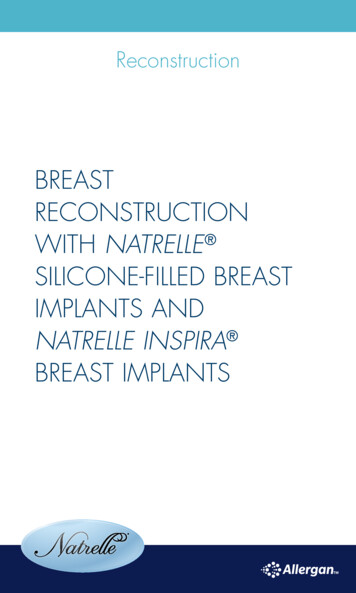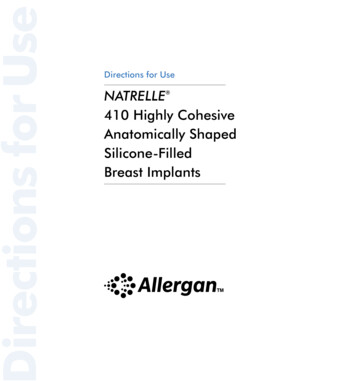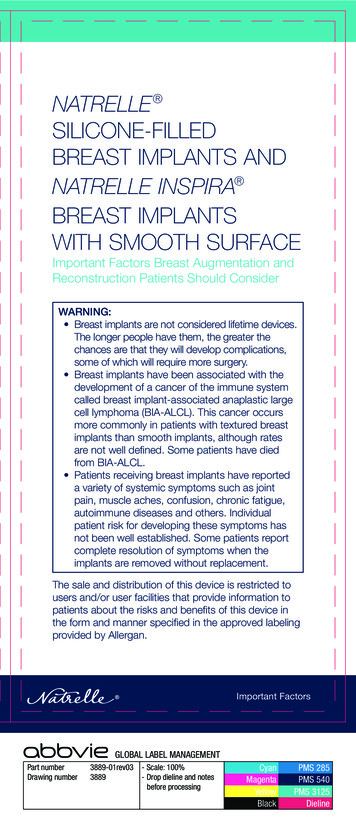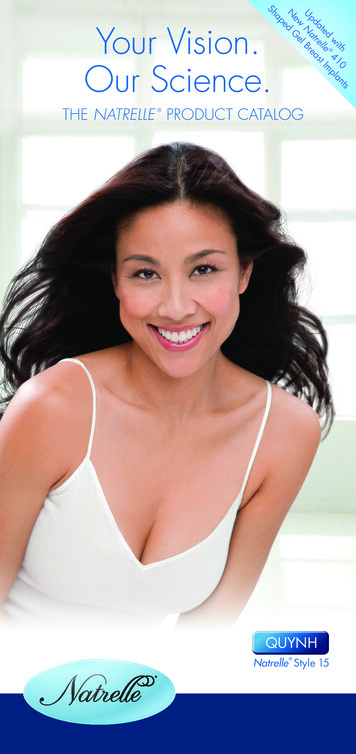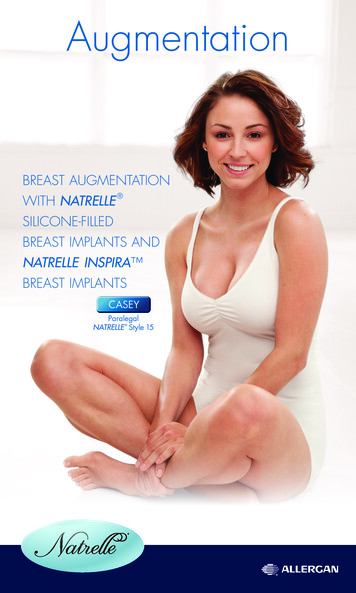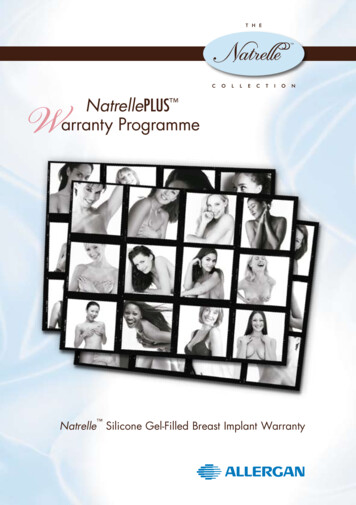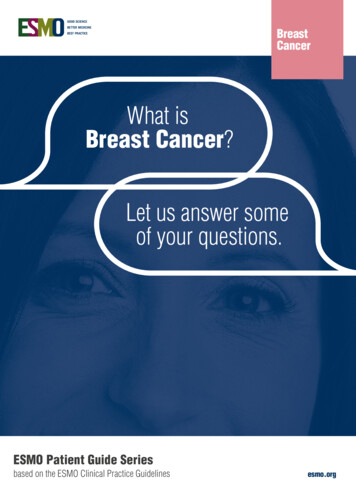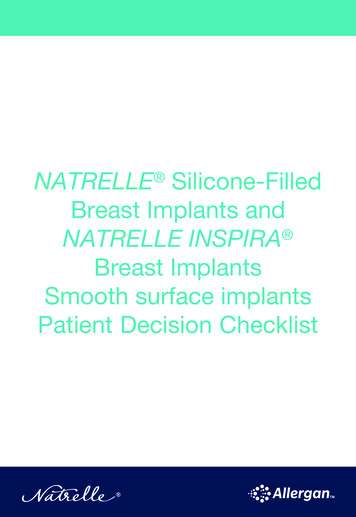Transcription
ReconstructionBREASTRECONSTRUCTIONWITH NATRELLE SILICONE-FILLED BREASTIMPLANTS ANDNATRELLE INSPIRA BREAST IMPLANTS
2
Table of ContentsGlossary .31. Considering Silicone Gel-Filled Breast Implant Surgery 111.1 What Gives the Breast Its Shape? . 121.2 What Is a Silicone-Filled Breast Implant? . 131.3 Who is eligible for NATRELLE Silicone-Filled Breast Implantsand NATRELLE INSPIRA Breast Implants, and what is theindication statement? . 141.4 What are the Contraindications? . 151.5 What are the Precautions? . 151.6 Warnings . 162.Breast Implant Benefits And Risks . 172.1 What are the Benefits? . 172.2 What are the Potential Risks? . 172.3 What Causes Breast Implants to Rupture and How Can I Tellif My Implants Are Ruptured?. 252.4 What Are Other Reported Conditions?. 273.Surgical Considerations For Breast Reconstruction . 323.1 Should You Have Primary Breast Reconstruction? . 333.2 What Are the Alternatives to Implantation with NATRELLE Silicone-Filled Breast Implants or NATRELLE INSPIRA BreastImplants? . 333.3 What Are the Choices in Primary Reconstructive Procedures? . 343.4 What Is Breast Reconstruction with Breast Implants? . 343.5 What Reconstruction Incision Sites Are Used? . 353.6 What About the Surgical Setting and Anesthesia? . 353.7 What Is the Timing of Primary Breast Implant Reconstruction? . 353.8 What Is the Primary Breast Implant Reconstruction Procedure?. 363.9 What About Primary Breast Reconstruction WithoutImplants (Tissue Flap Procedures)? . 383.10 What Are Some General Surgical Considerations? . 403.11 What Are Choices and Options AssociatedWith the Surgery? . 414.5.Follow-Up Examinations . 45Allergan’s Clinical Study Results .465.1 What are the Overview Findings of Allergan’s Core Study? . 475.2 What Are the 10-Year Follow-Up Rates? . 475.3 What Are the Benefits? . 475.4 What Are the 10-Year Complication Rates? . 495.5 What Are the Main Reasons for Reoperation? . 511
5.6 What Are the Main Reasons for Implant Removal? . 535.7 What Are Other Clinical Data Findings? . 546.Additional Information . 566.1 What If I Experience a Problem? . 566.2 What Is Device Tracking? . 566.3 What Is the ConfidencePlus Limited Warranty? . 576.4 How Can I Receive More Information? . 58For Further Reading And Information . 59Index . 65Acknowledgement of Informed Decision . 672
GlossaryAnaplastic large celllymphoma (ALCL)ALCL is not breast cancer; it is a rare typeof non-Hodgkin’s lymphoma, a cancerinvolving the cells of the immune system.AreolaThe pigmented or darker colored area ofskin surrounding the nipple of the breast.AsymmetryUneven appearance between a woman’sleft and right breasts in terms of size, shape,or breast level.AtrophyThinning or diminishing of tissues or muscle.Autoimmune diseaseAn autoimmune disease is a disease inwhich the body’s immune system attacksits own cells or tissues by mistake, causingdamage and dysfunction. Autoimmunediseases can affect connective tissue in thebody (the tissue that binds together bodytissues and organs). Autoimmune diseasescan affect many parts of the body, likenerves, muscles, glands, and the digestivesystem.BiocompatibleThe ability to exist along with living tissuesor systems without causing harm.BiopsyThe removal and examination of tissues,cells, or fluid from the body.Body DysmorphicDisorderA psychological condition characterized byexcessive worry about an imagined or minorphysical flaw to the point that it can interferewith normal daily activities.Body Esteem ScaleA questionnaire which asks about a person’sbody image.Breast augmentationA surgical procedure to increase breast size.For this brochure, it refers to placement ofa breast implant. The first time an implant isplaced for augmentation is called “primaryaugmentation.” Any time there is anothersurgery to replace the implant, it is referredto as “revision-augmentation.”Breast implantAny surgically implanted artificial deviceintended to replace missing breast tissue orto enhance a breast.Breast massA lump in the breast.3
Breast reconstructionA surgical procedure to replace breasttissue or reconstruct a breast after tissuewas taken out because of cancer or injury.Breast reconstruction also includes thesurgical correction of a breast that hasfailed to develop properly due to a severeabnormality or congenital defect. For thisbrochure, it refers to placement of a breastimplant.The first time a breast implant is placedto replace breast tissue is referred to as“primary reconstruction.” Any time there isanother surgery to replace the implant it isreferred to as “revision-reconstruction”CalcificationProcess of hardening by calcium salts.Capsular contractureA tightening of the scar tissue (also calleda capsule) that normally forms around thebreast implant during the healing processafter surgery. In some women, the scar tissue(capsule) squeezes the implant. When thisoccurs, it is called capsular contracture. Thisresults in firmness or hardening of the breastand is a risk for implant rupture. Capsularcontracture is classified by Baker Grades.Capsular contracture Baker Grades III andIV are the most severe. Baker Grade III oftenresults in the need for additional surgery(reoperation) because of pain and possiblyabnormal appearance. Baker Grade IVusually results in the need for additionalsurgery (reoperation) because of painand unacceptable appearance. Capsularcontracture Baker Grade II may also resultin the need for surgery. Each grade isdescribed below.16Baker Grade I: Normally soft and naturalappearanceBaker Grade II: A little firm, but breast looksnormalBaker Grade III: More firm than normal, andmay look abnormal (change in shape)Baker Grade IV: Hard, obvious distortion, andtenderness with painCapsuleScar tissue which forms around the breastimplant.4
Capsulotomy (closed)An attempt to break the scar tissue capsulearound the implant by pressing or pushingon the outside of the breast. This methoddoes not require surgery but may rupture theimplant and is contraindicated.Capsulotomy (open)An attempt to break the scar tissue capsulearound the implant by surgical incision intothe capsule.Congenital abnormalityAn abnormal development in part of thebody, present in some form since birth.Connective tissuedisease/disorder (CTD)A disease, group of diseases, or conditionsaffecting connective tissue, such as muscles,ligaments, skin, etc., and/or the immunesystem. Connective tissue diseases (CTDs)that involve the immune system includeautoimmune diseases such as rheumatoidarthritis, lupus, and scleroderma.ContraindicationA use that is improper and should not befollowed. Failure to follow contraindicationsidentified in the labeling could cause seriousharm.ContralateralOpposite side.Core StudyThe primary clinical study of augmentation,reconstruction, and revision (revisionaugmentation and revision-reconstruction)patients that supported the approval of thepremarket approval (PMA) application.Safety and effectiveness data are collectedyearly through 10 years, with the follow-upfrom years 5 through 10 being performedas part of a post-approval Core Study.Delayed wound healingUnusually slow progress in the healing ofa wound; surgical incision site fails to healnormally or takes longer to heal.DisplacementMovement of the implant from the usual orproper place.ExtrusionSkin breakdown with the implant pressingthrough the skin or surgical incision.FibromyalgiaA disorder characterized by chronic painin the muscles and soft tissues surroundingjoints, with tenderness at specific sites in thebody. It is often accompanied by fatigue.Fibrous tissuesConnective tissues composed mostly offibers.5
FlapA portion of tissue (which may includemuscle, fat, and skin) moved from one partof the body to another. The tissue flap mayor may not have its blood supply attached.Gel bleedWhen silicone gel leaks or “bleeds” ordiffuses through the implant shell.Gel fractureAppearance of a fissure or fault line inhighly cohesive gel in response to anapplied force.GranulomaA noncancerous lump that can form aroundany foreign material, such as silicone.Like any lump, it should be evaluated todistinguish it from a lump that might becancerous.HematomaA collection of blood within a space.Hypertrophic scarringAn enlarged scar that remains after a woundheals.IncisionA cut made to the tissue during surgery.InfectionThe growth in the human body ofmicroorganisms such as bacteria, viruses,or fungi. An infection usually results in fever,swelling, redness, and/or pain. It can occuras a result of any surgery.InflammationThe response of the body to infection orinjury that is characterized by redness,swelling, warmth, and/or pain.InframammaryBelow the breast.Inpatient surgeryA surgical procedure in which the patient isrequired to stay overnight in the hospital.LactationThe production and secretion of milk by thebreast glands.Latissimus dorsiTwo triangular muscles running from thespinal column to the shoulder.Low molecular weightsiliconesSmall silicone molecules that might leak outof the implant.6
Lymph nodesGlands that play an important part in thebody’s defense against infection. Theyproduce lymph, which travels throughoutthe body in the lymph system, and filtersimpurities from the body. Common areaswhere the lymph nodes can be felt with thefingers include: groin, armpit, neck, underthe jaw and chin, behind the ears, and onthe back of the head.LymphadenopathyEnlargement of the lymph node(s).LymphedemaSwelling of the lymph node(s).MalpositionWhen the implant is placed incorrectlyduring the initial surgery or when the implanthas shifted from its original position. Shiftingcan be caused by many factors, such asgravity, trauma, poor initial placement, orcapsular contracture.MammaryPertaining to the breast.MammographyA type of x-ray examination of the breastsused for detection of cancer.Screening mammography – x-rayexamination of the breast that is performedon women with no complaints or symptomsof breast cancer; the goal is to detect breastcancer when it is still too small to be felt bya physician or the patient.Diagnostic mammography – x-rayexamination in order to evaluate a breastcomplaint or abnormality detected byphysical exam or screening mammography;additional views of the breast are usuallytaken.MammoplastyPlastic surgery of the breast.7
MastectomyPartial or complete removal of the breastdue to the presence of a cancerous orprecancerous growth. Subcutaneous mastectomy: surgicalremoval of the breast tissues, but sparingthe skin, nipple, and areola. Total mastectomy: surgical removal of thebreast including the nipple, areola, andmost of the overlying skin. Modified radical mastectomy: surgicalremoval of the entire breast including thenipple, areola, and overlying skin, aswell as the lymphatic-bearing tissue in theaxilla. Radical mastectomy: surgical removalof the entire breast including the nipple,areola, and overlying skin, as well asthe pectoral muscles, lymphatic bearingtissue in the axilla, and various otherneighboring tissue.MastitisInflammation of the breast.MastopexySurgical procedure to raise and reshapesagging breasts.Metastatic diseaseA stage of cancer after it has spread from itsoriginal site to other parts of the body.MigrationMovement of silicone materials outside thebreast implant to other parts of the body.MRI (MagneticResonance Imaging)A radiographic examination that currentlyhas the best ability to detect rupture ofsilicone gel-filled breast implants.NecrosisDeath of cells or tissues.OncologistA medical doctor who specializes indiagnosing and treating cancer.Outpatient surgeryA surgical procedure in which the patient isnot required to stay in the hospital overnight.PalpabilityThe ability to feel the implant.PalpableFelt with the hand.PectoralisMajor muscle of the chest.PeriareolarAround the darkened or pigmented areasurrounding the nipple of the breast.Plastic surgerySurgery intended to enhance or improve theappearance of the body.8
PostoperativeAfter surgery.PrecautionsInformation that warns the reader of apotentially hazardous situation which, if notavoided, may result in minor or moderateinjury.Primary breastreconstructionThe first time a breast implant is placed forthe purpose of breast reconstruction.PtosisSagging or drooping of the breast.ReoperationAn additional surgery after your first breastimplantation.Revision-reconstructionRefers to the correction or improvement of aprimary reconstruction. For this brochure, itrefers to surgical removal and replacementof breast implants that were placedoriginally for primary breast reconstruction.Rheumatologic disease/disorderA variety of diseases involving connective tissuestructures of the body, especially the jointsand fibrous tissue. These diseases are oftenassociated with pain, inflammation, stiffness,and/or limitation of motion of the affectedparts. Can include autoimmune diseases.Fibromyalgia is a rheumatological disorder.Rosenberg Self-EsteemScaleA questionnaire that measures overallself-esteem.Rowland ExpectationScaleA 16 item questionnaire intended tomeasure expectations and perceived resultsof implant surgery.RuptureA hole or tear in the shell of the implantthat allows silicone gel filler material to leakfrom the shell. Ruptures can be intracapsular(inside the scar tissue capsule surroundingthe implant) or extracapsular (outside thescar tissue surrounding the implant).SalineA solution made of water and a smallamount of salt.Scar revisionA surgical procedure to improve theappearance of a scar.SeromaSimilar to a bruise, a seroma occurs when thewatery portion of the blood collects around asurgical incision or around a breast implant.SF-36 ScaleThe Short Form 36 Health Scale; aquestionnaire intended to measure physical,mental, and social health.9
Silent ruptureA breast implant rupture without symptomsor a visible change. Silent rupture cannot befelt by the woman or detected by a doctorthrough physical examination. Silent rupturecan only be discovered through appropriateimaging techniques such as MRI. Mostsilicone gel-filled breast implant ruptures aresilent (see symptomatic rupture below).Silicone elastomerA type of silicone that has elastic propertiessimilar to rubber.Subglandular placementPlacement of a breast implant underneathand within the breast glands but on top ofthe chest muscle.Submuscular placementPlacement of a breast implant wholly orpartially underneath the chest muscle.SymptomAny perceptible change in the body or itsfunctions that indicates disease or a phaseof a disease.SymptomaticExperiencing symptoms; any evidence or signof disease or disorder.Symptomatic ruptureA breast implant rupture that is associatedwith symptoms (such as lumps, persistentpain, swelling, hardening, or change inimplant shape). Some silicone breast implantruptures are symptomatic, but most are silent.SystemicPertaining to or affecting the body as awhole.Tissue expanderAn adjustable implant that can be inflated withsaline to stretch the tissue at the mastectomysite. This is used to create a new tissue flap thatis large enough to cover the breast implant.Toxic shock syndromeA rare, but life-threatening bacterial infectionthat may occur after surgery. It occurs mostoften in the vagina of menstruating womenusing superabsorbent tampons. Symptomsinclude sudden fever, vomiting, diarrhea,decreased blood pressure, fainting, dizziness,and sunburn-like rash. A doctor should be seenimmediately for diagnosis and treatment iftoxic shock syndrome is suspected.TransaxillaryUnder the arm.WarningStatement that alerts the reader about asituation which, if not avoided, could resultin serious injury or death.10
1.Considering Silicone Gel-FilledBreast Implant SurgeryYou may be considering breast implant surgery to restore your breastshape after a mastectomy or an injury that resulted in either partial ortotal loss of your breast(s) or to correct a birth defect. This is referredto as breast reconstruction. Or you may need to have implants from aprevious breast reconstruction corrected or improved, which is calledrevision-reconstruction. Whether you decide to have breast reconstructiondepends on your own individual case, medical condition, general health,lifestyle, emotional state, and breast size and shape. You may wish tospeak with your family, friends, breast implant support groups, and breastcancer support groups to help you in making this decision.If you are considering breast reconstruction and do not have a plasticsurgeon, ask your general surgeon for the names of experienced,board-certified plastic surgeons in your area. Your general surgeon, plasticsurgeon, and oncologist should work together to plan your mastectomyand reconstruction procedure to give you the best possible result.Allergan has prepared this information to help you better understand thebreast implant procedure and assist you in making an informed decisionabout breast reconstruction or revision-reconstruction surgery. It willhelp to answer some of the questions you may have about the surgeryand about breast implants in general. It will also provide you withspecific information about the risks and benefits of Allergan’s NATRELLE Silicone-Filled Breast Implants and NATRELLE INSPIRA Breast Implants.Similar information to help you understand breast reconstruction isavailable from your plastic surgeon, Allergan, or at www.natrelle.com.This information cannot and should not replace talking to your plasticsurgeon. Your decision on whether or not to get breast implants shouldbe based on realistic expectations of the outcome. There is no guaranteethat your results will match those of other women. Your results will dependon many individual factors, such as your overall health (including age),chest structure, breast/nipple shape and position, skin texture, healingcapabilities (which may be slowed by radiation and chemotherapytreatment, smoking, alcohol, and various medications), tendency tobleed, prior breast surgery, surgical team’s skill and experience, type ofsurgical procedure, and type and size of implant. Make sure you speakwith your surgeon about your expectations of the results, as well as whatyou can expect regarding the length of the surgery, your recovery, andany risks and potential complications of the surgery. Ask questions.As part of your decision, both you and your surgeon should signAllergan’s “Acknowledgement of Informed Decision” form that confirmsyour understanding of the risks and benefits of Allergan’s NATRELLE Silicone-Filled Breast Implants and NATRELLE INSPIRA Breast Implants.This form is located on page 67.11
Because breast implants will require monitoring and care for the rest ofyour life, you should wait 1-2 weeks after reviewing and consideringthis information before deciding whether to have primary breastreconstruction surgery. In the case of a revision-reconstruction, however,your surgeon may find it medically advisable to perform surgery sooner.1.1What Gives the Breast Its Shape?The breast consists of milk ducts and glands, surrounded by fatty tissuethat provides its shape and feel. Beneath the breast is the chest muscle(pectoralis major muscle).FATTY TI S S U ERIBSP E CTO R A L I S M U S CL E SMILK DUCTSA N D GL A N DSImplants are used to make the breast larger or to restore/replace breasttissue. Factors such as pregnancy (when milk glands are temporarilyenlarged), rapid weight loss, and the effects of gravity as you age,combine to stretch the skin, which may cause the breast to droop orsag. The implants alone may not adequately lift the breast, or correct theeffects of pregnancy, weight loss, or skin stretching. Your surgeon maysuggest additional procedures at the time of the breast reconstruction,such as mastopexy, to help achieve improved breast lift.Breast cancer surgery (full or partial mastectomy or lumpectomy) cangreatly change the shape and appearance of the breast. When awoman has a mastectomy some, much, or all of the breast tissue may beremoved, and some skin may be removed as well. There will be scarring,and the tissue (skin and breast tissue) may be more sensitive because ofthe surgery, or chemotherapy, and/or radiation treatments. All of thesecan affect the size, shape, and overall outcome of reconstruction withbreast implants.12
1.2 What Is a Silicone-Filled Breast Implant?A silicone gel-filled breast implant is a sac (implant shell) of siliconeelastomer (rubber) filled with silicone gel. Allergan has approval for 3 typesof silicone gel fillers: Responsive silicone gel, SoftTouch silicone gel, andHighly Cohesive silicone gel. This brochure focuses on round implants filledwith Responsive silicone gel, SoftTouch silicone gel, and Highly Cohesivesilicone gel. A separate brochure is available for anatomically shapedimplants filled with Highly Cohesive silicone gel from your plastic surgeon,from Allergan, or at www.natrelle.com.Allergan offers two lines of round silicone-filled breast implants: NATRELLE Silicone-Filled Breast Implants and NATRELLE INSPIRA Breast Implants.NATRELLE Silicone-Filled Breast Implants are filled with Responsivesilicone gel. NATRELLE INSPIRA Breast Implants are filled with Responsivesilicone gel (NATRELLE INSPIRA Responsive Breast Implants), SoftTouchsilicone gel (NATRELLE INSPIRA SoftTouch Breast Implants), and HighlyCohesive silicone gel (NATRELLE INSPIRA Cohesive Breast Implants).Refer to Section 3.11 for more information on the different NATRELLE Silicone-Filled Breast Implants and NATRELLE INSPIRA Breast Implantsavailable from Allergan.Product NameGel FillingNATRELLE Silicone-Filled Breast ImplantsResponsive siliconeNATRELLE INSPIRA Responsive Breast ImplantsResponsive siliconeNATRELLE INSPIRA SoftTouch Breast ImplantsSoftTouch siliconeNATRELLE INSPIRA Cohesive Breast ImplantsHighly Cohesive silicone Example of a NATRELLE Silicone-Filled Breast Implant13
Example of NATRELLE INSPIRA Breast ImplantExample of NATRELLE INSPIRA Textured Breast Implant1.3 Who is eligible for NATRELLE Silicone-FilledBreast Implants and NATRELLE INSPIRA Breast Implants, and what is the indicationstatement?NATRELLE Silicone-Filled Breast Implants and NATRELLE INSPIRA Breast Implants have been approved for females for the following uses(procedures): Breast augmentation for women at least 22 years old. Breastaugmentation includes primary breast augmentation to increase thebreast size, as well as revision surgery to correct or improve the resultof a primary breast augmentation surgery. Breast reconstruction. Breast reconstruction includes primary breastreconstruction to replace breast tissue that has been removed dueto cancer or trauma or that has failed to develop properly due toa severe breast abnormality. Breast reconstruction also includesrevision surgery to correct or improve the result of a primary breastreconstruction surgery.A separate patient brochure is available for those women consideringbreast augmentation surgery and should be read prior to reaching adecision to undergo breast augmentation.14
1.4 What are the Contraindications?A contraindication is a condition or circumstance that, if present, means aprocedure should not be done. Contraindications for breast implant surgeryare discussed in this section.Breast implant surgery should not be performed in: Women with active infection anywhere in their body, because theimplant will make the infection much harder to treat should the infectionmove into the breast. Women with existing cancer or pre-cancer of their breast who havenot received adequate treatment for those conditions, becauseradiation and chemotherapy treatments may increase the risk of somecomplications seen with breast implants. Also, breast implants mayinterfere with radiation or chemotherapy treatments. Women who are currently pregnant or nursing, because surgerymay interfere with the safety of the pregnancy/nursing. Since breastreconstruction is an elective surgery, it should be postponed until youare no longer pregnant or nursing.1.5 What are the Precautions?A precaution is information that warns the reader of a potentiallyhazardous situation which, if not avoided, may result in minor or moderateinjury. The following are precautions; safety and effectiveness have notbeen established in patients with these conditions: Autoimmune diseases (for example, lupus and scleroderma) A weakened immune system (for example, currently taking drugs thatweaken the body’s natural resistance to disease) Planned chemotherapy following breast implant placement Planned radiation therapy to the breast following breast implantplacement Conditions that interfere with wound healing and blood clotting Reduced blood supply to breast tissue Clinical diagnosis of depression or other mental health disorders,including body dysmorphic disorder and eating disorders. Pleasediscuss any history of mental health disorders with your surgeon priorto surgery. Patients with a diagnosis of depression, or other mentalhealth disorders, should wait until these conditions have resolved orstabilized prior to undergoing breast implantation surgery.15
1.6 WarningsWarnings are statements that alert the reader about a situation which,if not avoided, could result in serious injury or death. Read this entirebrochure before having breast implant surgery. This is important so thatyou will understand the risks and benefits and have realistic expectationsof the outcome of your surgery. Breast implants are associated with manyshort-term and long-term risks.WARNING – Be aware that there are many factors that will affectthe outcome and timing of your reconstruction with breast implants.These factors include the stage of your disease, the type and extentof cancer removal surgery you have had, the amount of skin and softtissue available for the reconstruction, and additional treatments such aschemotherapy and radiation, which you may require.WARNING – Be aware that many of the changes to your breastfollowing implantation cannot be undone. If you later choose tohave your implant(s) removed and not replaced, you may experienceunacceptable dimpling, puckering, wrinkling, or other cosmetic changesto the breast, which can be permanent.WARNING – Before you decide to have breast implant surgery,you should know that breast implants are not lifetime devices, andbreast implantation is likely not a one-time surgery. You will likely needadditional unplanned surgeries on your reconstructed and/or oppositeaugmented breasts because of complications or unacceptable cosmeticoutcomes. These additional surgeries can include implant removalor replacement, or they can include other surgical procedures. Latersurgeries to replace implants (revision-reconstruction) carry higher risksof complications than the first (primary) reconstruction surgery. Therefore,you should also consider the complication rates for revision-reconstructionsince you may experience these risks in the future.WARNING – Your NATRELLE Silicone-Filled Breast Implants orNATRELLE INSPIRA Breast Implants may rupture without any symptoms(silent rupture). This means that neither you nor your surgeon will knowthat your implants have ruptured. In order to detect silent rupture, youwill need to have regular screening MRI examinations. You should havean MRI 3 years after your breast implant surgery and then every 2 yearsafter that for as long as you have your breast implants.16
2.Breast Implant Benefits And RisksUndergoing any type of surgical procedure involves risks such as theeffects of anesthesia, infection, swelling, redness, bleeding, pain, andeven death. Some of these risks are serious, and all of these risks needto be balanced against the benefits of the surgery. These benefits andrisks of breast implants are described below. At the end of this brochureis a list of published studies used to gather the information discussed inthe sections below. These studies may be helpful to you if you wish tolearn more about a specific complication or condition. The reference listis not complete because studies are being conducted all the time. Yourphysician may have other resources for further reading. The informationprovided below focuses on women undergoing primary reconstruction orrevision-reconstruction with NATRELLE Silicone-Filled Breast Implants orNATRELLE INSPIRA Breast Implants. The studies in the list of referencesalso include women undergoing breast augmentation and other typesof implants from a variety of manufacturers. The risks and benefits ofaugmentation may differ from those for breast reconstruction, and therisks of other types of implants may differ from those of NATRELLE Silicone-Filled Breast Implants and NATRELLE INSPIRA Breas
1. C onsidering Silicone Gel-Filled Breast Implant Surgery 11 1.1 W hat Gives the Breast Its Shape? . 12 1.2 W hat Is a Silicone-Filled Breast Implant? . 13 1.3 W ho is eligible for NATRELLE Silicone-Filled Breast Implants an d NATRELLE INSPIRA Breast Implants, and what is the
